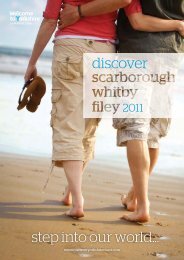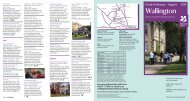Whitby & North York Moors Guide - Days Out Leaflets
Whitby & North York Moors Guide - Days Out Leaflets
Whitby & North York Moors Guide - Days Out Leaflets
You also want an ePaper? Increase the reach of your titles
YUMPU automatically turns print PDFs into web optimized ePapers that Google loves.
The Parish Church of St Mary the Virgin has<br />
its foundation in Anglo Saxon times, when<br />
<strong>Whitby</strong> was called Streoneshalh. But with the<br />
coming of the Normans it is believed to have<br />
been rebuilt by Serlo de Percy and his brother<br />
William around 1110. Subsequent generations<br />
have altered and enclosed the original<br />
structure and now only the chancel and parts<br />
of the southwest walls are of Norman origins.<br />
Did you know?<br />
The highest point of the east coast<br />
of England is located on <strong>York</strong>shire’s<br />
Heritage Coast. The cliffs to the<br />
north of Boulby (near Staithes) are<br />
a staggering 200m high!<br />
<strong>Whitby</strong> - steep<br />
steps and tall tales<br />
few know <strong>Whitby</strong>’s history and quirky peculiarities as well as<br />
Harry Collett - local story-walker. Harry kindly shared some of<br />
the town’s secrets with us.<br />
There is a right way, a wrong way, and a<br />
<strong>Whitby</strong> way. This saying, well-known to the<br />
inhabitants of the seaport, is perhaps best<br />
explained by asking you to consider all the<br />
ports on the eastern seaboard of England.<br />
They all have a north bank and a south<br />
bank but in <strong>Whitby</strong>, there is an East Cliff and<br />
a West Cliff. Very important, particularly<br />
should you be searching for the strange<br />
and supernatural.<br />
Stand at the Whale Bone Arch early in the<br />
morning looking across to the East Cliff and,<br />
during the summer months, you can see<br />
the sun rising out of the sea. Likewise on<br />
an evening, stand in the same spot, turn 90<br />
degrees and you will see the sun set into the<br />
sea. The dying rays reflect in the windows<br />
to the left of the clock tower of St Mary’s<br />
Church, giving the impression that two red<br />
22<br />
eyes are staring at you (see below right).<br />
Those eerie eyes were observed by Irish<br />
author, Bram Stoker, from the reading room<br />
in the first floor of the Royal Hotel, and<br />
mentioned in his famous novel, Dracula.<br />
In that publication a Russian ship ran<br />
aground on Tate Sands in a terrific storm.<br />
What many people do not realise is that<br />
five years before Stoker wrote Dracula, a<br />
Russian ship really did run aground on<br />
those selfsame sands.<br />
The difference between fact and fiction<br />
was that in the fictional version the Irish<br />
writer told of the vessel’s dead Captain,<br />
tied to the steering wheel, clutching his<br />
crucifix and rosary. In real life the Captain<br />
was prosecuted for being drunk and<br />
incapable whilst in charge of his vessel.<br />
He wasn’t dead, merely dead drunk!<br />
Inside the church are many curious features.<br />
The roof, made in the 17th century by ships’<br />
carpenters, gives the appearance of “tween<br />
decks” on a wooden ship. The gallery masking<br />
the chancel arch dates from 1612 and was<br />
built for Lord Richard Cholmley, Lord of the<br />
Manor. It is said that the triple-decker pulpit<br />
was erected to prevent two members of the<br />
House of Lords claiming seniority, so that<br />
when the Bishop of <strong>Whitby</strong> was in town he<br />
could preach from the top story, level with the<br />
Lord of the Manor in his private pew across<br />
the Chancel arch. Heaven forbid that one Lord<br />
should be higher than the other, especially in<br />
the house of the Lord!<br />
The first Abbey, dedicated to St Peter and<br />
ruled over by St Hilda, was the setting for the<br />
Synod of 664. Missionaries from Ireland had<br />
converted the northern regions to Christianity,<br />
while Monks from Rome had converted the<br />
south. King Oswy, King of <strong>North</strong>umbria,<br />
wished to reconcile the two churches and<br />
called the great Synod of Streonshalh, with<br />
representations from both Celtic and Roman<br />
denominations. The main disagreement was<br />
over the timing of Easter.<br />
When it was pointed out that the Abbey was<br />
dedicated to St Peter, founder of the Church<br />
of Rome and to whom Christian tradition says<br />
the keys to Heaven were presented, the Celtic<br />
Bishops conceded to King Oswy’s authority.<br />
Thus the moveable feast of Easter, based on<br />
the phases of the moon, united Christians<br />
under the banner of the Church of Rome.<br />
In 867 the Abbey was laid waste by the Danes<br />
and the remains of St Hilda and others were<br />
recovered and removed south to be reburied<br />
in Glastonbury in the Kingdom of Wessex.<br />
The Abbey was re-established twice more.<br />
Once by Benedictine monks following the<br />
Norman invasion in 1066, but they were<br />
forced to flee inland when the Vikings<br />
returned to the eastern seaboard in 1153<br />
and destroyed the Abbey.<br />
The final rebuild is estimated to have<br />
commenced in 1220, and continued until the<br />
15th century. It was surrendered to Henry<br />
VIII in 1540, but due to the dissolution of<br />
the monasteries, the Abbey was despoiled<br />
of everything of value and the land and<br />
buildings were sold to the Cholmley family.<br />
Throughout the ensuing centuries it speedily<br />
turned into ruins, although a little restoration<br />
work was conducted after World War One.<br />
To get to the Church of St Mary’s and the<br />
Abbey on foot, one needs to climb the 199<br />
church stairs. The number of stairs has been<br />
for a long time a matter of controversy. In<br />
June 1761, Anglican Priest, John Wesley,<br />
wrote that he had preached atop a hill,<br />
ascended by 191 steps. Nineteenth century<br />
guidebooks claimed a total of 194 steps<br />
based on counting the landings.<br />
During major restorations in 1877 the Church<br />
authorities decided it should be settled once<br />
and for all. The two church wardens testified<br />
that there were 199 steps and inscribed it on a<br />
stone tablet with their initials set in stone in<br />
the graveyard wall to the right of the top step.<br />
The correct way to be buried in <strong>Whitby</strong> was<br />
to be lifted or carried up the stairs. It was<br />
a question of economics really. To get to<br />
the graveyard by horse-drawn hearse is a<br />
two mile trot up Green Lane and around<br />
the Abbey: an expensive option. So instead<br />
you’d ask your friends “If I go first will you<br />
carry me up, and if you go first I will arrange<br />
for you to be carried up!” That is why there<br />
opposite, main image: <strong>Whitby</strong><br />
abbey. inset: St mary’s Church. This<br />
page, top: Steps to <strong>Whitby</strong> abbey.<br />
are landings every so far up for the pall<br />
bearers to rest the coffins on. Being <strong>York</strong>shire<br />
folk we did not wish a pall bearer to drop<br />
dead and the vicar to have two for the price<br />
of one! It’s just another of those little pieces<br />
of the jigsaw that make up the saying a right<br />
way, a wrong way and a <strong>Whitby</strong> way!<br />
Join Harry on a walk around <strong>Whitby</strong> and learn about<br />
the town’s rich history, its connection with the strange<br />
and supernatural, and how it provided<br />
the inspiration for Dracula.<br />
• Heritage Town Tours<br />
• <strong>Whitby</strong> Ghost Walk<br />
• In Search of<br />
Dracula Trail<br />
Tel: 01904 821 734<br />
Email: info@whitbywalks.com<br />
www.whitbywalks.com<br />
<strong>Whitby</strong> and the <strong>North</strong> <strong>York</strong> <strong>Moors</strong> Holiday <strong>Guide</strong> 2012 | 23
















